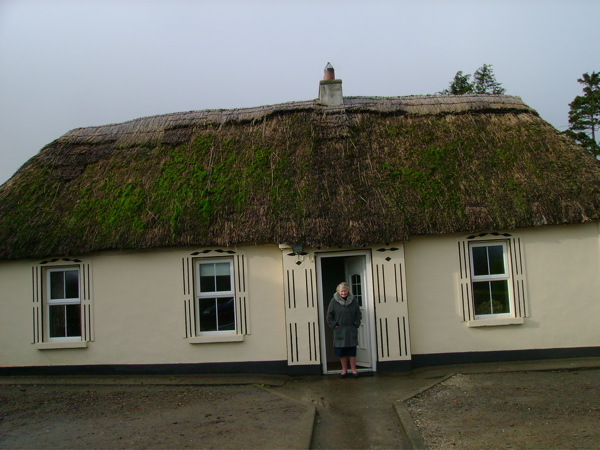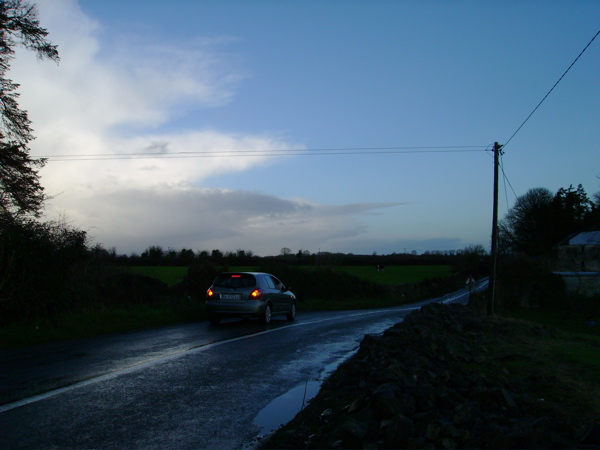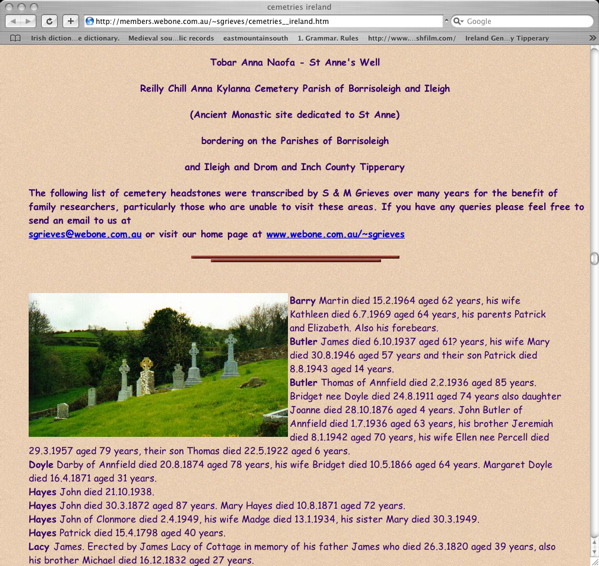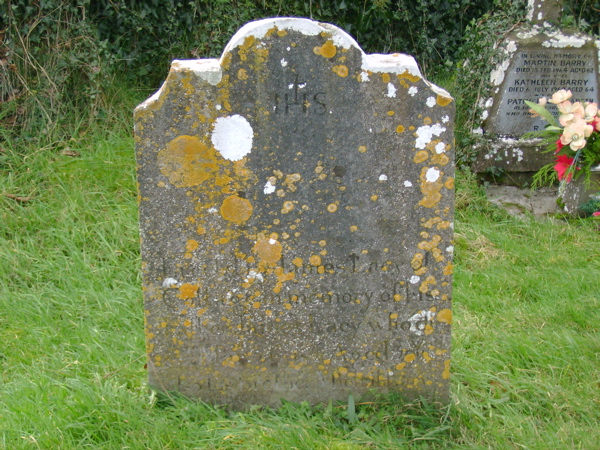“Where are we from in Ireland, Mom?” “My father always said the Laceys are from Tipperary. “Tipperary is the name of a city and a county in Ireland Mom. Which is it?” “How the hell do I know. All is know is ‘It’s a long way to Tipperary, it’s a long way to go. It’s a long way to Tipperary, to the sweetest girl I know.’ When your father and I went to Ireland we didn’t go to Tipperary. Your father said it really was a long way to go. He wanted to visit the tourist spots in the west part of Ireland instead.” This was the extent of family history passed on to my by my Irish American mother; a song about Tipperary, written in England during World War I, perhaps written as a means to recruit the recalcitrant Irish into the British military.
I am the first person in my family to locate and travel to the town that we came from in Ireland. It turns out that CountyTipperary is only about 60 miles southwest of the Dublin Airport and the place where my family lived is just 75 miles from Dublin. Given the road conditions, the west part of Ireland is a much longer way to go.
It is 2007 and I am sitting in the Tipperary Studies Department of the Thurles Library in Ireland looking for books and reading the microfilm of every County Tipperary daily newspaper from January 1, 1847 through December 31, 1849. I am looking for Lacey family history and in particular one ancestor who disappeared between 1848 and 1849, James Lacey .
From what I read in these local newspapers it looks like the people’s history of Ireland during The Great Hunger, my people’s history was never recorded in any books nor barely mentioned in any newspapers. “You will only find mention of the local people if something unusual happened,” the librarian tells me. I have read all the newspapers so I know unusual is a polite code word for murdered or murderer. Why else would a poor person’s name appear in the news? Why do I think the newspapers back then report anything different than today’s news? Anyway I am here in Ireland reading every paper just in case.
I often think about how our family would not have come to be but for the courage of James Lacey’s wife Sally Peters, who came alone to America with her three young children. Sarah or (Sally) Peters Lacey and her three children made it to the United States where Sally joined up with her father Patrick Peters and the rest of her family. They were all recorded living together in the United States Census records of 1850 but James Lacey was not with them.
I know the exact location to search for James Lacey before I arrive in Ireland. The county in Ireland, Tipperary, and the names of my last ancestors to live in Ireland were passed on to me through my family’s oral history. The Catholic Church in Ireland has records dating back to the beginning of the 19th Century. I did my research, received the baptismal records of the Lacey children as well as the marriage record for James Lacey and Sally Peters. These records give me the old name of the town land where the Lacys lived before the family came to the United States.
I get lucky and find a site on the Internet that posts the inscription off a family gravestone. Sue Grieves, an Australian woman of Irish ancestry spent her summer vacation in Ireland, recording inscriptions off gravestones and created a website called “Cemetery Headstone Transcriptions Ireland”. Sue lists her email address in Australia so I send her an email of thanks but she does not reply back to me.
The James Lacey gravestone is in the Kylanna Cemetery in County Tipperary. The inscription on the stone reads:
Erected by James Lacy of Cottage in memory of his father James who died 26.3.1820, aged 39 years also his brother Michael died 16.12.1832 aged 27 years.
I know by the location of the cemetery along with the place mentioned on the gravestone that this is most likely my ancestor James Lacey because the location is the same as what is I see listed on my Lacey records from Catholic Church in Ireland. I also know the name Lacey was originally spelled Lacy, from the name de Lacy.
My first day in Ireland I head straight to the Tipperary History Center in the Thurles Library to look at the tax records for the townland of Cottage in the 1840’s. Townlands are farmland areas where populations of people once lived as tenants and rented acres of land. Cottage, the farmland area in Tipperary County, where James Lacey lived, is between the towns of Thurles and Borrisoleigh in an area of a few square miles about 75 miles south west of Dublin.
By the 18th century Catholics in Ireland were excluded from most areas of public life including severe restrictions or exclusion in land ownership. The Lacys lived like the majority of Ireland, as tenants on small agricultural holdings. They raised a few crops and livestock. The principal commodity, barreled meat and animal by-products went to the landlords to pay the rent for the use of the land.
The poorer people supplemented farming with whatever other work was available. In many areas of Ireland the supplemental work was textiles, the spinning and weaving of woolen and linen cloth. Tipperary County also had mines. The Silvermine Mountains are about fifteen miles from where the Lacys lived. These mountains were named two hundred years earlier when silver was discovered there about 1640. The silver was quickly mined out of the Silvermine Mountains but the mines also contained lead. Lead was still being mined there at the time of James Lacy. Other nearby mountains had coal as well. I imagine, ”Perhaps this is the place my Irish ancestors first held jobs as miners .” The newspaper in 1848 advertised that with the discovery of several rich lead veins “that the number of laborers will, in a few days, be increased to two hundred.” It went on to say, “Give the Celts as interest in the land, and they will not neglect to perform their duty.’
All tax records for the 1840’s are in books called the Poor Law Union Rate Books. A Poor Law Union was an area of local government in the UK from the 19th century in which local taxable inhabitants were financially responsible for all the paupers in their area. The Poor Law Relief Act of 1838 divided Ireland into Unions. Each Union was then further divided into smaller areas called electoral districts. Each electoral district kept a set of records. These records are another place where Irish ancestry can be found.
Every landlord in Ireland passed on responsibility for a portion of the tax to each of their tenants based on the tenant’s number of acres and buildings. People had paid their rent primarily through a barter system for six hundred years. This new taxation system set up in the Poor Law Relief Act of 1838 required cash payment. Coming at the same time as the potato blight this was a devastation. The Irish economic system depended on potatoes not cash and they had neither.
Potatoes arrived in Britain on ships from the Americas in 1588. The Irish started growing potatoes soon afterwards. English landowners in Ireland had control of the better land where the cereal grains could grow. Potatoes grew in abundance on very little land. One or two acres could feed a family and its livestock. The English saw no use for the potato. England’s ruling class thought the potato was a threat to civilization. After all the potato came from an uncivilized society, America. They believed the potato caused immorality and laziness. Wheat was what hard working civilized people grew. Wheat was not something that could be harvested and eaten straight away. It had to be threshed, milled, mixed, kneaded and baked before it could be eaten.
By the late 18th century, after two hundred years of eating potatoes, the population in Ireland had increased from 3 million to 8 million people. English economists were reporting that eating potatoes was the cause of Ireland’s overpopulation. It had nothing to do with the nutrients in the potato. The problem was that potatoes were too easy to grow. They could be grown in what they called a “lazy bed”, a mound of dirt with a trench on either side. Growing potatoes required so little effort the Irish had too much food and too much time on their hands. Unlimited food = unlimited sex = overpopulation = misery! Adam Smith wrote that the commodity market like the price of bread is what curbs population control. Population control reduces the labor force and keeps the economy in balance. Too many people in the labor force drives wages down. “Potatoes removed the restraints that kept the population in check.”
Economists were concerned with another problem with the potato. They did not see the possibility of the potato as a true commodity, A commodity must first satisfy a human want and then second it can be exchanged for another thing. Grains could be stored and converted into money to buy other things. Unlike grains, potatoes could not be easily stored. Potatoes were subject to the whims of nature. Any product that would not store had no exchange value and should never be converted into money. Therefore the potato was not a commodity. The grain in Ireland was a commodity. That meant it was destined to follow the money to England, not to feed the penniless Irish.
Charles Darwin’s Descent of Man was published in the mid 19th century. In it Darwin says, “the carefree, squalid, uninspiring Irishmen multiply like rabbits.” This was the accepted thinking of the times. When the potato blight hit, many in English society were ready to see it as divine providence.
In 1846 and 1847 there was a depression going on throughout the capitalist world. England was hardest hit and capitalists were looking for ways to reduce the labor force and help profits to rise. Factories were shut down all over England and English iron workers, factory workers and miners were striking.
On October 23, 1847 Frederick Engels published an article called The Commercial Crises in England. In it he said:
“The commercial crisis to which England finds itself exposed at the moment is, indeed, more severe than any of the preceding crises. Neither in 1837 nor in 1842 was the depression as universal as at the present time…In the meantime starving Ireland is writhing in the most terrible convulsions. The workhouses are overflowing with beggars, the ruined property owners are refusing to pay the Poor Tax, and the hungry people gather in their thousands to ransack the barns and cattle-sheds of the farmers and even of the Catholic priests, who were still sacred to them a short time ago.”
As always, when capitalism is in crisis those most vulnerable, find themselves the victims and are forced completely out of economic productivity. The London Times newspaper had regular reports about “nature taking care of” the overpopulation problems in Ireland. There was little sympathy for the Irish.
I think about all these forces my ancestors were up against as I sit in the library in Ireland searching for news of what happened to them. I search the newspapers for reports on the landlord to see if there were forced clearances off the land in 1848. Forced clearances entailed the landlord and a few hired men going from house to house with battering rams, breaking down the front doors, throwing all belongings outside of the house and tearing off the roof, leaving the homes uninhabitable.
Reports on clearances appear in the Irish newspapers through letters to the editor.
(September 13, 1848) On Monday last the sheriff came and took possession of our land, the house in which I and my children were born, the farm I and my father occupied for the last 66 years, and paid 65 years’ rent…if permitted to thresh my seven acres of corn, I could have ample means to liquidate the entire debt due to my landlord.
On Tuesday the sheriff proceeded to the lands of Killahy, and ejected James and Hugh Ryan from a well cultivated farm of about eighty acres which was held by the family for more than a century….Just as they were about to put a sickle into the corn, the landlord, with the sheriff at his back, seized their all.
In the 19th century, most of Ireland, and all of Tipperary County was divided into estates. By the 18th century the land in Tipperary was given to English Earls who were then provided Irish titles. The rich agricultural land areas outside of towns were divided into hundreds of townlands. Cottage was on the Estate of the Earl of Clonmel, a man named John Scott who was given the land in 1789. By 1848 when my family was forced to leave the land it was in the hands of the 3rd Earl of Clonmel, John Henry Scott.
In 1848 dozens of families left the townland of Cottage and the adjoining townlands of Paddock, Dogstown and Pallas but I found no mention of evictions there in any newspaper. The Toomyvara eviction, the largest eviction of a single townland in one day, 731 reported people, happened not twenty miles from Cottage in April of 1849. The Toomyvara story had only one short paragraph written about it in the paper. Could it be that most evictions did not even make it to the newspapers unless someone died?
(January 19, 1848) Judith Doheny was ejected off a little farm at Cooleen, near Borrisoleigh, by the landlords James and John Parker. She wandered about in much want without any shelter, and finally entered her former abode on the 18th August last. For this forcible possession she was tried and sentenced to six months’ confinement, which punishment she was undergoing when her death occurred. An inquest was held and verdict was returned of “died from natural causes.”
Eventually I find a mention of the Earl of Clonmel evicting tenants in another area. The September 13, 1848 newspaper says,
On Monday last the agent of Lord Clonmel attended by the sheriff, police, and bailiffs, evicted nine poor families, in all about fifty souls, from the townlands of Ballinamona and Carrough. Nothing could be more distressing that to hear the clanking of the crowbars demolishing the cabins, mingled with the most pitiful and heartrending shrieks of woman and children.
I switch from reading the newspapers to the books. I find James Lacey in the books of the Borrisoleigh Electoral District of the Thurles Poor Law Union. The Thurles Library has most of the Borrisoleigh Electoral District Rate Books for the 1840’s. These are beautiful leather bound books with copper plated writing and calligraphy style penmanship. Each name is carefully written although the spelling of each name is not consistent from year to year. I find Lacy also spelled as “Lacey” one year and “Leacy” another year. The rate books show the tax records of James Lacy up through 1847. There are many other tenants in Cottage on the books as well, Hanly, Bourke, Ryan, McGrath, Kennedy, Lowrey, Butler, and Hogan to name a few.
I examine the rates that the people were paying. They paid tax of 5 shillings in the pound per acre twice a year in June and December. There is one column that shows if the tax was paid and another that indicates if any tax payment was in arrears. Unlike some, James Lacy was paid in full and not in arrears. The tax in December of 1846 was cut in half of what it was in previous times. The year 1847 shows something else. The people were taxed in May of 1847 and made to pay a four-fold increase and then again in October of 1847 another increase fifteen times more than they were paying in December 1846. This amounted to a 900% increase in less than one year! Still James Lacy was paid in full and not in arrears.
I show the books to the librarian John who knows I am reading newspapers to look for clearance notices and he says, “Well there’s your answer. Now you know why they left.”
The newspaper mentions the establishment of an Insolvent Commission in Tipperary. This commission states, “ the tax afforded the clearance-mongers the most effective means” of getting rid of the agricultural population. Some landlords were praised as humane for forgiving three or four years rent or accepting whatever people could pay. These landlords were in the minority and the ratepayer books prove that the landlord of Cottage was not one of them.
The ratepayers’ book for 1848 is missing and the book for 1849 is in much worse condition than the earlier books. Unlike the other books, the rate book for 1849 is torn and muddy and has what appear to be bloodstains on its pages. It is as if the book is telling me what happened that awful year. I search for James Lacy’s name and find it gone along with all the other tenants. The families Ryan, Bourke, Magrath, Kennedy, Lowrey, Carroll, Shanahan, Hickey, Cleary, Murphy, Kelly, Stapleton, Butler, Connell, Lowrey, Hogan, Hickey, Hynes, Peters, Gilmartin, Delany, Byrnes, Dwyer, Bradshaw and Lacy are all gone from this land.
© 2007 Margaret Cooley



